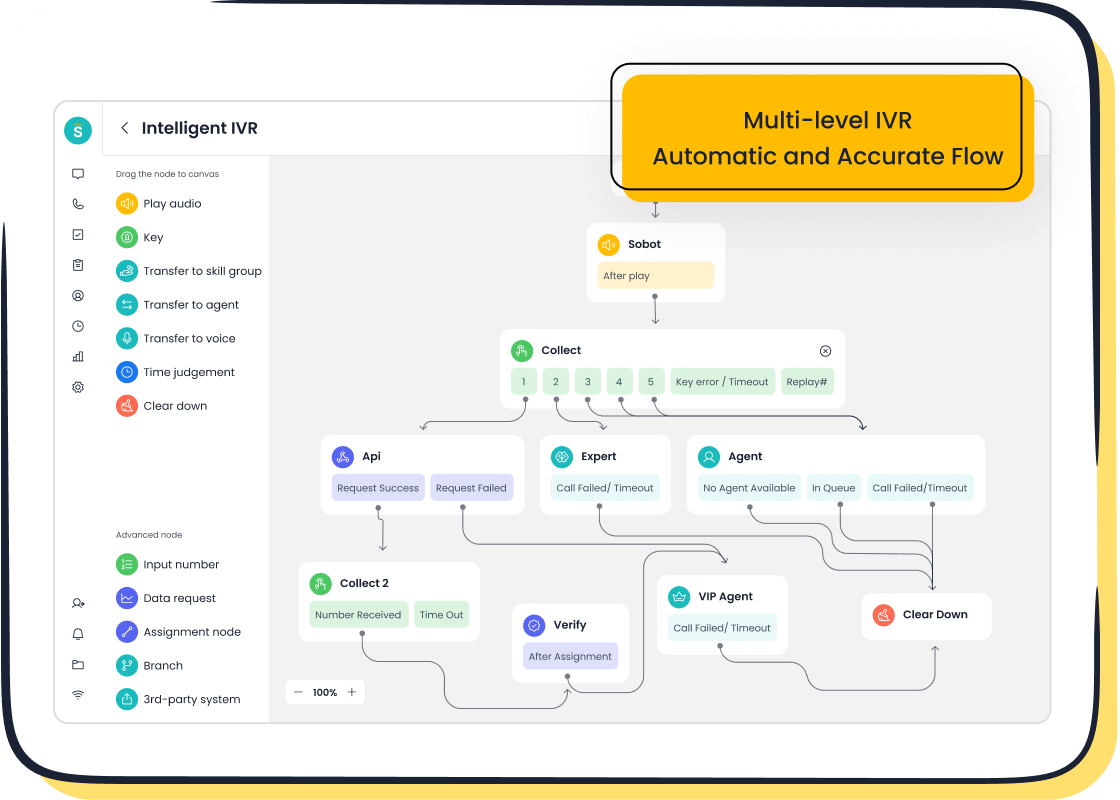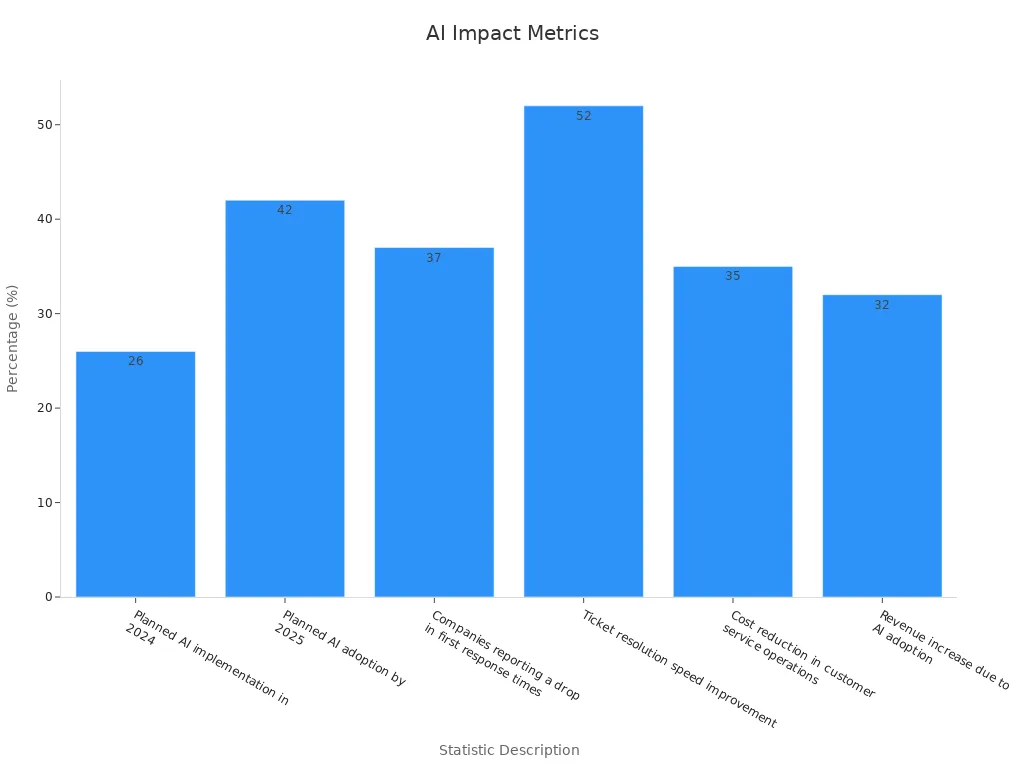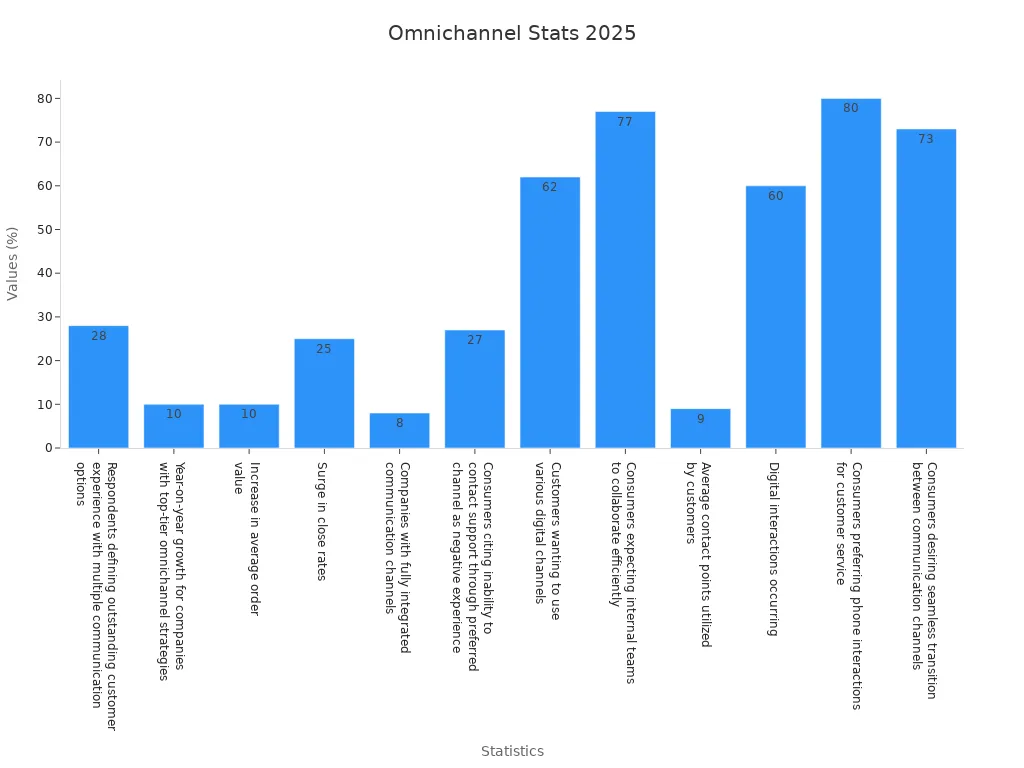Understanding Omnichannel Contact Centers in 2025

An omnichannel contact center connects all communication channels into one unified system, letting you interact with customers seamlessly. Whether it's email, social media, or voice calls, you can provide consistent service across every platform. This approach ensures that you meet customer expectations for fast and personalized support. By 2025, businesses are increasingly adopting these solutions. For example, 92% of companies now use AI-driven personalization to improve customer service. The market for omnichannel engagement is also projected to grow significantly, reaching $17.92 billion in sales by 2030. Platforms like Sobot’s omnichannel contact center solution empower you to stay ahead in this competitive landscape.
What Is an Omnichannel Contact Center?
Definition and Core Concept
An omnichannel contact center is a unified platform that connects all customer communication channels into a single system. It allows you to manage interactions across voice, email, chat, social media, and more without losing context. This seamless integration ensures that customers receive consistent and personalized service, regardless of the channel they choose.
The core concept of an omnichannel contact center revolves around creating a cohesive customer experience. Instead of treating each channel as a separate entity, it combines them into one streamlined system. This approach not only improves customer satisfaction but also enhances operational efficiency. For businesses, adopting an omnichannel approach is no longer optional. It has become essential for staying competitive in today's fast-paced market.
- Omnichannel experiences are critical for survival in competitive industries.
- Successful implementation requires clear goals and the right technology.
- Contact center software supports this by managing interactions across multiple channels, optimizing both inbound and outbound operations.
By integrating voice, video, chat, and social media, an omnichannel contact center simplifies customer interactions. It also provides tools like omnichannel routing and workforce engagement management to improve productivity.
Difference Between Multichannel and Omnichannel
At first glance, multichannel and omnichannel contact centers may seem similar. Both involve multiple communication channels. However, the way these channels function sets them apart.
-
Multichannel Contact Centers: These operate channels independently. For example, if a customer starts a conversation on social media and later calls your support team, the two interactions remain disconnected. This lack of integration often leads to frustration. Studies show that customer satisfaction drops by 61% when customers must switch channels to resolve the same issue.
-
Omnichannel Contact Centers: These integrate all channels into a single system. Customers can switch between channels without losing context. For instance, if a customer begins a chat on your website and later calls, the agent can access the entire conversation history. This seamless transition enhances the customer experience and boosts satisfaction.
By choosing an omnichannel contact center, you ensure that your customers enjoy a smooth and consistent journey across all touchpoints.
Key Standards for Omnichannel Contact Centers
To deliver exceptional service, an omnichannel contact center must meet specific standards. These standards ensure that your system operates efficiently and provides a superior customer experience.
- Unified Communication: All channels must connect seamlessly. This integration allows agents to access customer data and interaction history in one place.
- Personalization: The system should use customer data to offer tailored experiences. Personalized interactions build trust and loyalty.
- Real-Time Synchronization: Updates across channels should happen instantly. This ensures that customers receive accurate and timely information.
- Scalability: Your contact center should grow with your business. It must handle increasing volumes of interactions without compromising performance.
- Security and Compliance: Protecting customer data is crucial. Your system must comply with industry regulations and ensure data privacy.
By adhering to these standards, you can create an omnichannel contact center that meets customer expectations and drives business success.
How Does an Omnichannel Contact Center Work?
Integration of Communication Channels
An omnichannel contact center integrates all communication channels into a single, unified system. This integration allows you to manage customer interactions seamlessly across platforms like email, social media, voice calls, and live chat. Instead of juggling multiple tools, you can access everything in one place, ensuring a consistent experience for your customers.
The integration process involves connecting various channels to create a unified customer view. This feature consolidates all interactions into a single profile, making it easier for agents to provide personalized support. For example, if a customer starts a conversation on social media and later switches to email, the entire interaction history remains accessible. This eliminates repetitive questions and improves satisfaction.
Here’s a breakdown of key features that support integration:
| Feature | Description |
|---|---|
| Unified Customer View | Consolidates all customer interactions into a single profile for easy access and management. |
| Easy Channel Integration | Links all communication channels and supports efficient call routing to enhance customer experience. |
| Advanced Analytics and Reporting | Provides insights into response times, resolution rates, and customer satisfaction for performance evaluation. |
By leveraging these features, you can streamline operations and deliver a cohesive customer experience. Sobot’s omnichannel contact center solution excels in this area, offering tools that unify communication channels and optimize workflows.
Role of Cloud Technology in Omnichannel Contact Centers
Cloud technology plays a pivotal role in enabling omnichannel contact centers. It provides the infrastructure needed to integrate multiple channels into a single platform while ensuring scalability and flexibility. With cloud-based contact centers, you can deploy solutions quickly and reduce upfront costs, making them ideal for businesses of all sizes.
The demand for cloud-based systems continues to grow. The market for cloud-based contact centers is projected to reach USD 162.5 billion by 2033, driven by the adoption of omnichannel communication strategies. This growth reflects the increasing need for improved customer experiences across various channels. Additionally, 39% of contact centers in the U.K. have already migrated to the cloud, and 57% plan to transition within the next three years.
Cloud technology also supports remote work, which has become essential in today’s business environment. By 2025, projections indicate that 60 to 90 million Indians will work remotely, emphasizing the need for systems that enable remote agent functionality. Cloud-based contact centers meet this demand by offering flexible and scalable solutions, advanced analytics, and omnichannel support.
Key benefits of cloud technology include:
- Increased demand for flexible and scalable customer service solutions.
- Enhanced customer engagement through AI-powered analytics and omnichannel support.

Sobot’s omnichannel cloud contact centers leverage cloud technology to provide a stable and secure platform. With features like AI-powered voicebots and real-time data synchronization, Sobot ensures your contact center operates efficiently, even in remote environments.
Sobot’s Omnichannel Contact Center Solution
Sobot’s omnichannel contact center solution stands out as a comprehensive platform for managing customer interactions. It integrates voice, email, chat, and social media channels into a unified workspace, allowing you to deliver seamless and personalized service. With advanced features like AI-driven automation and intelligent IVR, Sobot helps you optimize workflows and improve customer satisfaction.
The solution’s performance metrics validate its effectiveness. For instance, businesses using Sobot have reported a 20% reduction in inbound discussion volume and a 96% increase in positive feedback. Over 80% of customer queries are answered correctly by the AI platform, contributing to a CSAT score of 97%. Additionally, self-service options resolve 22.2% of questions, reducing the workload on agents.
| Metric | Result |
|---|---|
| Reduction in inbound discussion volume | 20% |
| Increase in positive feedback | 96% + |
| Correct answers by AI platform | Over 80% |
| Customer satisfaction | Over 95% |
| Self-service question resolution | 22.2% |
| CSAT score | 97% |
| Problem resolution rate | 85% |
| Customer happiness | 99% |
| Sign-off rate | Increased by 35% |
| COD collection rate | Increased by 40% |

Sobot’s solution empowers you to enhance customer interactions while reducing costs and improving efficiency. Its unified workspace, AI capabilities, and robust analytics make it a valuable tool for businesses aiming to deliver exceptional service.
Benefits of Omnichannel Contact Centers

Enhanced Customer Experience Across Channels
An omnichannel contact center transforms how you deliver customer service by creating a seamless experience across all communication channels. Customers no longer need to repeat themselves when switching from email to live chat or social media. Instead, agents can access the entire interaction history, ensuring personalized and efficient support.
Studies show that 62% of consumers believe brands should show more care in their interactions. Additionally, 60% are more likely to purchase when they feel valued. By adopting omnichannel customer service, you can meet these expectations and build stronger relationships. For example, integrating customer data allows faster issue resolution, reducing response times and improving satisfaction.
| Benefit | Description |
|---|---|
| Improved Customer Satisfaction | Omnichannel contact centers enhance customer satisfaction by providing seamless communication across channels. |
| Reduced Response Times | By integrating customer data, issues can be resolved more quickly, leading to faster response times. |
| Increased Revenue | Companies with strong omnichannel solutions see an average 9.5% year-over-year revenue increase. |
By focusing on customer experience management, you can create meaningful engagements that drive loyalty and satisfaction.
Improved Agent Productivity and Efficiency
Omnichannel contact centers empower your agents to work smarter, not harder. With a unified workspace, agents can manage multiple channels without switching between tools. This streamlined approach reduces average handle time and boosts productivity.
For instance, businesses using omnichannel communications report a 20% decrease in average handle time and a 77% increase in remote agent productivity. These improvements translate into better customer support and higher satisfaction rates. Agents can focus on resolving complex issues while automation handles repetitive tasks, ensuring effective customer support.
| Metric | Improvement |
|---|---|
| Productivity of remote agents | 77% increase |
| Average handle time | 20% decrease |
| Customer satisfaction | 64% increase |
Sobot’s omnichannel solution enhances agent efficiency by integrating tools like AI-powered chatbots and intelligent IVR. These features reduce workload and improve service quality, helping you achieve operational excellence.
Data-Driven Insights for Business Growth
Omnichannel contact centers provide valuable data that drives business growth. By analyzing customer interactions, you can identify trends, optimize processes, and improve engagement strategies. For example, Domino’s leveraged data-driven insights to boost digital orders, which accounted for 65% of U.S. sales in 2020.
| Company | Evidence of Growth |
|---|---|
| Domino's | By 2020, digital channels accounted for over 65% of U.S. orders, contributing to comparable-store sales growth of 7.1% in 2019. The digital overhaul revitalized brand perception and generated new revenue streams from data-driven promotions. |
| Walmart | Omnichannel sales accounted for over 60% of Walmart’s U.S. digital revenue, with online sales growing more than 35% yearly. Customer satisfaction scores for pickup services doubled, contributing to overall same-store sales growth. |
Sobot’s omnichannel customer service solution includes advanced analytics, enabling you to track performance and refine strategies. These insights help you stay competitive and achieve sustainable growth.
Key Features of Omnichannel Contact Centers
Unified Communication Platform
An omnichannel contact center thrives on its ability to unify communication channels into a single platform. This feature ensures that you can manage customer interactions across voice, email, chat, and social media without switching between tools. By consolidating all channels, you gain a complete view of customer history, enabling personalized and efficient service.
Unified communication platforms improve key performance metrics that validate their effectiveness. For example:
- First-Call Resolution (FCR): Agents solve customer problems on the first interaction, showcasing effective call routing.
- Average Speed of Answer (ASA): Faster response times reflect efficient queuing systems.
- Average Call Duration (ACD): Balanced call lengths indicate that agents address issues thoroughly without rushing.
Sobot’s omnichannel solution excels in this area. Its unified workspace integrates customer data and interaction history, allowing agents to deliver seamless service. This approach boosts customer satisfaction and loyalty, while enhancing agent efficiency.
AI and Automation Capabilities
AI and automation redefine how you manage customer interactions. These technologies handle repetitive tasks, freeing agents to focus on complex issues. Predictive analytics and AI-powered chatbots improve ticket resolution speed and reduce first response times, enhancing operational efficiency.
Research highlights the impact of AI adoption:
| Statistic Description | Value |
|---|---|
| Planned AI implementation in 2024 | 26% |
| Planned AI adoption by 2025 | 42% |
| Ticket resolution speed improvement | 52% |
| Cost reduction in customer service operations | 35% |
| Revenue increase due to AI adoption | 32% |

Sobot’s AI-driven automation tools, such as intelligent IVR and AI-powered voicebots, optimize workflows and improve service quality. These features help you save time, reduce costs, and deliver consistent support across all channels.
Real-Time Data Synchronization
Real-time data synchronization ensures that updates across channels happen instantly. This feature eliminates delays and inaccuracies, allowing you to provide timely and relevant information to customers. For example, if a customer switches from live chat to a phone call, the agent can access the latest interaction details without missing a beat.
This capability also enhances customer insights. By capturing valuable data, you can identify trends, optimize processes, and improve the overall customer experience. Businesses using real-time synchronization report higher customer satisfaction and loyalty rates, as well as improved agent productivity.
Sobot’s omnichannel contact center solution integrates real-time data synchronization seamlessly. Its advanced analytics tools provide actionable insights, helping you refine strategies and achieve sustainable growth.
Scalability and Customization Options
Scalability and customization are essential for any omnichannel contact center. These features ensure your system adapts to changing business needs while delivering personalized customer experiences. Whether your business is growing or facing seasonal demand fluctuations, an omnichannel solution provides the flexibility to scale resources efficiently.
Cloud-based omnichannel contact centers excel in scalability. They allow you to adjust resources based on demand, ensuring optimal performance without overspending. For instance, during peak seasons, you can scale up to handle increased customer interactions. When demand decreases, you can scale down to save costs. This flexibility improves resource allocation and budgeting, making your operations more efficient.
Customization options further enhance the value of an omnichannel contact center. You can tailor workflows, communication channels, and automation tools to meet your specific business requirements. For example, integrating AI-powered voice bots can automate up to 66% of inbound interactions. This reduces reliance on human agents, cutting operational costs by 37.6% and boosting efficiency by 3.46 times. Additionally, customer satisfaction scores often increase by over 22% when systems are customized to address unique customer needs.
| Aspect | Details |
|---|---|
| Challenge | High operational costs and inefficiencies due to reliance on human agents |
| Solution | AI-powered Voice Bot automated 66% of inbound interactions |
| Efficiency Increase | 3.46X boost in efficiency |
| Cost Savings | Total Cost of Ownership reduced by 37.6% |
| Customer Satisfaction | CSAT increased by 22.4% |
| Operational Improvement | Average handle time dropped by 38.6% |
Omnichannel solutions also support long-term growth. By enhancing agent productivity, businesses can achieve a 9.5% annual revenue increase. These tools not only streamline operations but also provide the flexibility to adapt to future challenges. With the right customization, your contact center becomes a powerful asset for delivering exceptional service.
Tip: Choose an omnichannel platform that offers both scalability and customization. This ensures your system grows with your business while meeting customer expectations.
Sobot’s omnichannel contact center solution provides unmatched scalability and customization. Its cloud-based infrastructure allows you to scale effortlessly, while its advanced tools let you personalize workflows and communication channels. This combination ensures your business stays agile and competitive in a dynamic market.
Implementation Strategies and Best Practices
Assessing Business Needs and Goals
Before implementing an omnichannel solution, you need to evaluate your business needs and goals. Start by identifying the challenges your contact center faces. Are customers experiencing delays? Are agents struggling to manage multiple channels? Understanding these pain points helps you set clear objectives.
Focus on key performance indicators (KPIs) like customer satisfaction scores and Net Promoter Scores. These metrics reveal the quality of your customer interactions and highlight areas for improvement. For example, integrating AI and cloud-based tools can enhance operational efficiency and improve customer experiences. By aligning your goals with these benchmarks, you can create a roadmap for success.
Choosing the Right Omnichannel Contact Center Solution
Selecting the right solution is critical for your omnichannel strategy. Evaluate potential platforms based on performance indicators such as Average Handling Time (AHT), First Call Resolution (FCR), and Customer Satisfaction (CSAT). These metrics ensure the solution meets your operational needs.
| Performance Indicator | Description |
|---|---|
| First Call Resolution (FCR) | Measures the percentage of inquiries resolved during the first contact. |
| Customer Satisfaction (CSAT) | Gauges customer satisfaction after interactions through surveys. |
| Service Level Agreement (SLA) Compliance | Tracks the ability to meet predefined service level targets. |
Sobot’s omnichannel solution excels in these areas. It integrates channels seamlessly, reduces handling times, and improves customer satisfaction. This makes it an ideal choice for businesses aiming to deliver exceptional service.
Training Agents for Omnichannel Success
Training your agents ensures they can navigate an omnichannel contact center effectively. Focus on metrics like Call Handling Time and First Call Resolution Rate to measure training success. Regular feedback loops and iterative training sessions help agents adapt to real-time challenges.
| Metric | Description |
|---|---|
| Call Handling Time | Indicates the efficiency of agents in managing customer calls, helping identify training needs. |
| First Call Resolution Rate | Measures the ability of agents to resolve issues on the first contact, reflecting training success. |
| Customer Satisfaction Score | Assesses the overall customer experience, providing insights into the effectiveness of training programs. |
Encourage continuous learning by fostering open communication. This approach ensures your team stays prepared to handle complex customer interactions, enhancing the overall success of your omnichannel strategy.
Monitoring and Continuous Improvement
Continuous improvement ensures your omnichannel contact center stays efficient and meets customer expectations. Monitoring performance metrics helps you identify areas for enhancement and refine your strategies over time. By focusing on data-driven insights, you can optimize workflows and deliver better service.
Start by tracking key performance indicators (KPIs). These metrics reveal how well your contact center operates and highlight opportunities for improvement. For example, monitoring average handling time shows how quickly agents resolve issues. First-contact resolution rates measure how often problems are solved during the initial interaction. Higher rates reduce costs and improve customer satisfaction.
Tip: Use historical data and real-time analytics to guide your decisions. This approach helps you allocate resources effectively and improve agent productivity.
Omnichannel strategies offer significant benefits when paired with continuous improvement models. They can increase customer satisfaction by 20-30% on average. Eliminating repetitive information gathering reduces handling time, allowing agents to focus on complex issues. Improved first-contact resolution rates lead to cost savings and happier customers.
- Benefits of Continuous Improvement:
- Boosts customer satisfaction by up to 30%.
- Reduces average handling time through streamlined processes.
- Enhances first-contact resolution rates, lowering operational costs.
Data-driven workforce management (WFM) plays a vital role in continuous improvement. It uses analytics to optimize staffing and improve agent satisfaction. By analyzing historical trends, you can predict peak times and adjust schedules accordingly. Real-time data ensures your team remains agile and responsive to customer needs.
Note: Regularly review your KPIs and adjust your strategies to maintain high performance. Continuous improvement keeps your contact center adaptable and competitive.
Sobot’s omnichannel solution supports monitoring and improvement with advanced analytics tools. These features help you track performance, refine workflows, and achieve sustainable growth. By prioritizing continuous improvement, you ensure your contact center delivers exceptional service every time.
Challenges in Adopting Omnichannel Contact Centers
Integration Complexity
Integrating multiple communication channels into a single omnichannel system can be challenging. Each channel, such as email, voice, or social media, operates differently. Aligning these systems requires advanced technology and careful planning. For example, managing data quality and aligning performance indicators often create hurdles. Conflicts between business units over channel autonomy or customer databases can further complicate the process.
A study highlights specific challenges businesses face during integration:
| Challenge Type | Specific Issues |
|---|---|
| Logistics | Lack of inventory visibility across channels, inventory replenishment difficulties |
| Data Management | Managing data quality and aligning performance indicators |
| Organizational Barriers | Conflicts over channel autonomy and customer databases |
| Technology Barriers | Difficulties in selecting and implementing integration technologies |
To overcome these barriers, you need a clear strategy and the right tools. Solutions like Sobot’s omnichannel platform simplify integration by unifying all channels into one system, reducing complexity and improving efficiency.
Cost of Implementation
The initial cost of implementing an omnichannel contact center can seem high. Expenses include technology investments, integration, training, and ongoing maintenance. However, these costs often lead to long-term benefits. For instance, improved efficiency and customer retention can outweigh the upfront investment. Multichannel systems may appear cheaper initially but often result in hidden costs due to inefficiencies.
Investing in a customer-first operation can yield significant returns. Businesses have reported up to a 700% ROI over 12 years. This return comes from increased revenue and reduced operational costs. By focusing on long-term gains, you can justify the initial expense and build a more efficient system.
Resistance to Change Within Teams
Adopting an omnichannel contact center often requires a shift in mindset. Teams accustomed to traditional systems may resist new workflows. This resistance can stem from a lack of understanding or fear of change. Training and clear communication are essential to address these concerns.
Encourage your team to see the benefits of an omnichannel approach. Highlight how it simplifies their work by consolidating channels and automating repetitive tasks. When agents understand the value of the system, they are more likely to embrace it. Regular feedback and support can also ease the transition, ensuring a smoother implementation process.
Ensuring Data Security and Privacy
Data security and privacy are critical in omnichannel contact centers. Customers trust you with their personal information, and safeguarding that trust is essential. A single data breach can damage your reputation and lead to significant financial losses. Prioritizing robust security measures ensures your customers feel safe and valued.
You must implement strategies that protect customer data across all communication channels. Encryption, for example, secures sensitive information during transmission. Multi-factor authentication (MFA) adds an extra layer of protection, ensuring only authorized personnel access your systems. Regular audits and compliance with data protection regulations, such as GDPR or CCPA, further strengthen your security framework.
Tip: Train your team to recognize phishing attempts and follow best practices for handling sensitive data. Human error often contributes to security breaches.
Statistics highlight the importance of robust data security:
- 70% of consumers avoid companies that fail to protect their data.
- Effective data management and cybersecurity best practices keep customer information secure.
- Strong data protection strategies improve the overall customer experience.
Real-time data synchronization, a key feature of omnichannel contact centers, requires extra attention. Ensure your system updates securely without exposing vulnerabilities. Partnering with a trusted provider like Sobot can simplify this process. Sobot’s omnichannel solution prioritizes data encryption and compliance, giving you peace of mind.
By focusing on security and privacy, you not only protect your customers but also enhance their trust in your brand. A secure contact center fosters loyalty and positions your business as a reliable choice in a competitive market. Take proactive steps today to safeguard your operations and deliver exceptional service.
Future Trends for Omnichannel Contact Centers in 2025

AI-Driven Personalization
AI-driven personalization is transforming how you interact with customers. By leveraging AI tools, you can tailor every interaction to meet individual needs. For example, AI can analyze customer data to predict preferences and recommend solutions. This approach not only enhances the customer experience but also improves efficiency. Studies show that AI tools reduce call durations by 45% and resolve issues 44% faster than human agents. Additionally, companies using AI in customer service report a 32% increase in revenue.
Automation plays a key role in this trend. By 2025, 85% of customer interactions are expected to occur without human agents. Generative AI will also become a game-changer, with 70% of customer service leaders planning to deploy it across touchpoints. These advancements highlight the growing importance of AI in your omnichannel strategy. As the market for AI in customer service grows to $4.1 billion by 2027, adopting these tools will help you stay competitive.
Expansion of Voice and Video Channels
Voice and video channels are becoming essential components of omnichannel contact centers. Customers increasingly prefer real-time communication for complex issues, making these channels vital for delivering exceptional service. Businesses offering omnichannel service report a 23x higher customer satisfaction rate, emphasizing the value of integrating voice and video.
The demand for these channels is driving market growth. The contact center software market is expected to grow at a CAGR of 23.9% from 2023 to 2030. AI and automation further enhance these channels by improving call routing and analyzing customer sentiment during interactions. For example, monitoring live call volume helps you adjust staffing, while tracking average wait times ensures timely responses. By expanding voice and video capabilities, you can create a more engaging and effective omnichannel strategy.
Increased Focus on Customer Success Metrics
Customer success metrics are becoming a cornerstone of omnichannel strategies. These metrics help you measure the effectiveness of your contact center and identify areas for improvement. Companies with robust omnichannel engagement retain up to 89% of their customers, highlighting the importance of tracking these indicators.
Metrics like Net Promoter Scores (NPS) and Customer Satisfaction (CSAT) provide valuable insights into customer loyalty and happiness. For instance, 91% of consumers report experiencing poor customer service, underscoring the need for quality assurance. By focusing on these metrics, you can refine your processes and deliver a superior customer experience. This approach not only boosts satisfaction but also drives long-term loyalty, ensuring your omnichannel contact center remains a key asset for your business.
Sustainability and Ethical Practices in Customer Service
Sustainability and ethical practices are reshaping customer service in omnichannel environments. Customers today expect businesses to prioritize environmental and social responsibility. By adopting sustainable practices, you can enhance your brand reputation and improve customer satisfaction.
Sustainable practices in customer service include reducing waste, using eco-friendly materials, and optimizing energy consumption. For example, Alfonsino, a food delivery service in Italy, integrates environmental sustainability into its operations. This approach has improved customer satisfaction in its omnichannel environment. Customers value businesses that respect the environment, as shown in a 2022 Deliverect report. These efforts not only benefit the planet but also create a positive impression on your customers.
Ethical practices also play a crucial role in customer service. Treating customers with fairness and transparency builds trust. For instance, providing clear information about your products and services ensures customers make informed decisions. Ethical practices extend to how you handle customer data. By prioritizing data privacy and security, you demonstrate respect for your customers' trust.
In an omnichannel contact center, sustainability and ethics can be integrated seamlessly. You can use digital tools to reduce paper usage and energy-efficient systems to lower your carbon footprint. AI-driven solutions can optimize workflows, reducing resource consumption. These measures align with customer expectations for responsible business practices.
By focusing on sustainability and ethics, you not only meet customer demands but also contribute to a better future. These practices enhance loyalty, improve satisfaction, and position your business as a leader in the omnichannel landscape.
Tip: Start small by adopting eco-friendly tools and transparent policies. Gradually expand your efforts to create a lasting impact.
Omnichannel contact centers have become indispensable for modern businesses. They unify communication channels, enabling seamless interactions that meet evolving customer expectations. Studies show that 73% of consumers desire smooth transitions between channels, while 77% expect internal teams to collaborate efficiently. These systems not only enhance customer satisfaction but also drive measurable business growth. Companies with top-tier omnichannel strategies experience a 10% year-on-year growth and a 25% surge in close rates.

Prioritizing omnichannel strategies in 2025 ensures your business stays competitive. Customers increasingly demand personalized experiences across multiple touchpoints, with 62% preferring digital channels and 80% still valuing phone interactions. By adopting these solutions, you can deliver exceptional service, build loyalty, and achieve sustainable growth.
FAQ
What is the difference between omnichannel and multichannel contact centers?
Omnichannel contact centers integrate all communication channels into one system. This allows you to provide seamless customer experiences. Multichannel contact centers, on the other hand, operate channels independently. Customers often face disconnected interactions when switching between channels in multichannel systems.
How does an omnichannel contact center improve customer satisfaction?
Omnichannel systems let you access a customer’s interaction history across all channels. This eliminates repetitive questions and ensures personalized support. Customers feel valued when their issues are resolved quickly and efficiently, which boosts satisfaction.
Can small businesses benefit from omnichannel contact centers?
Yes! Omnichannel solutions scale to fit businesses of any size. Small businesses can use these systems to streamline operations, reduce costs, and improve customer experiences. Tools like AI chatbots and unified workspaces make it easier to manage customer interactions effectively.
What role does AI play in omnichannel contact centers?
AI automates repetitive tasks, such as answering common questions. It also analyzes customer data to predict needs and recommend solutions. This improves efficiency and allows agents to focus on complex issues, enhancing the overall customer experience.
Is data security a concern in omnichannel contact centers?
Yes, but robust systems address this. Encryption, multi-factor authentication, and compliance with regulations like GDPR ensure data security. Choosing a trusted provider, like Sobot, helps you protect customer information and maintain trust.
Tip: Always train your team on best practices for handling sensitive data to avoid breaches.
See Also
A Comprehensive Guide to Omnichannel Contact Center Implementation
Essential Insights on Omnichannel Call Center Software Solutions
Discovering Leading Cloud Contact Centers for 2025
